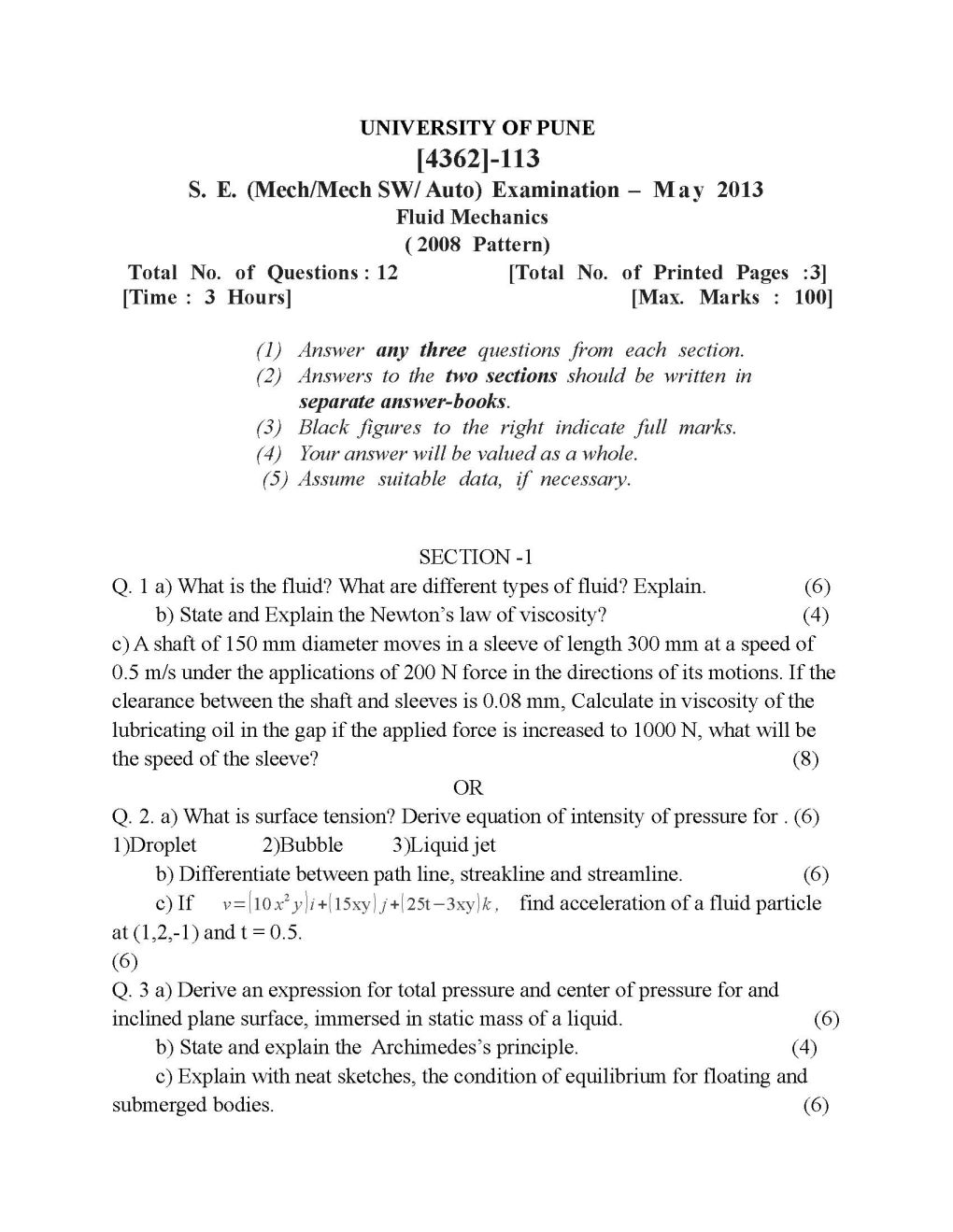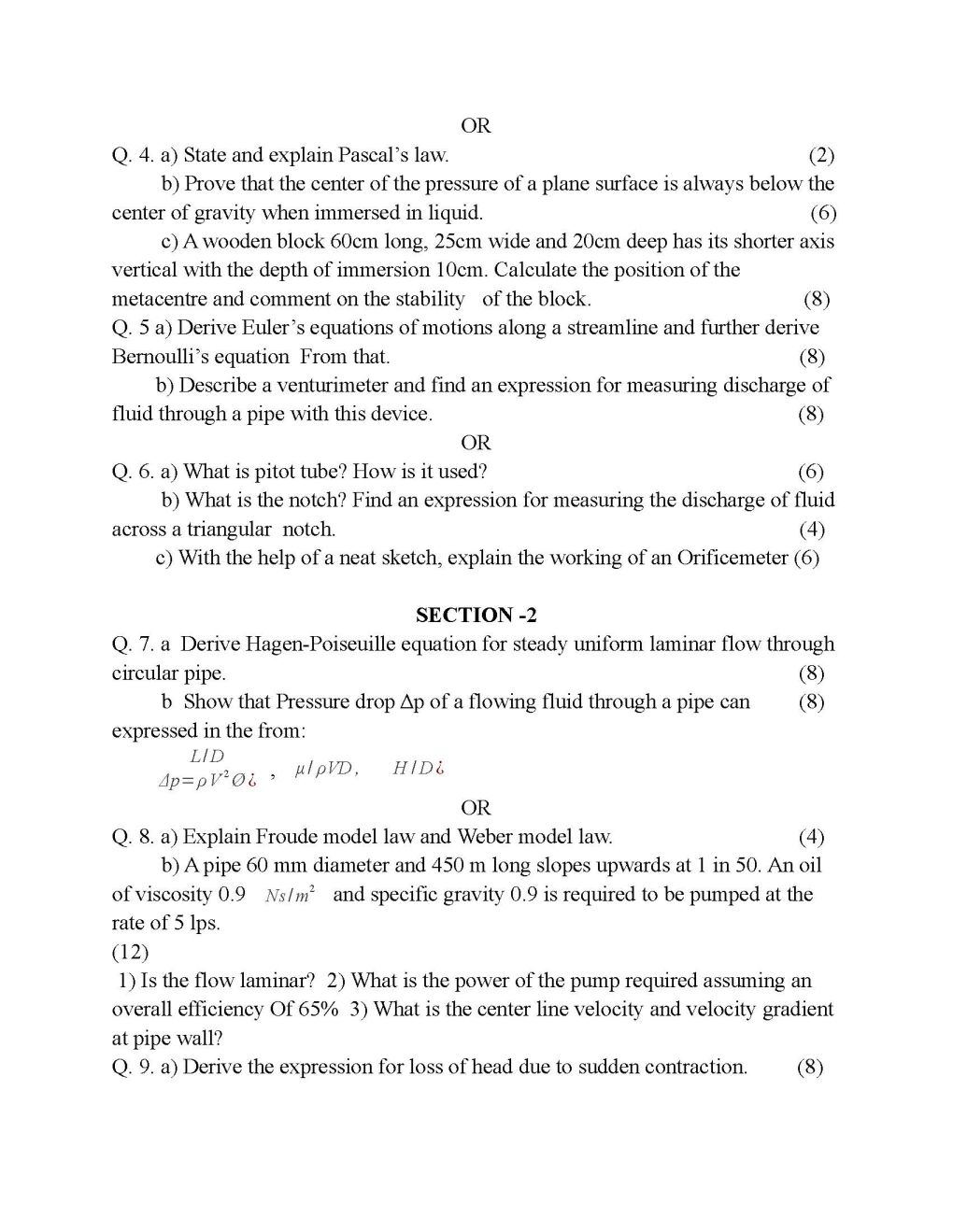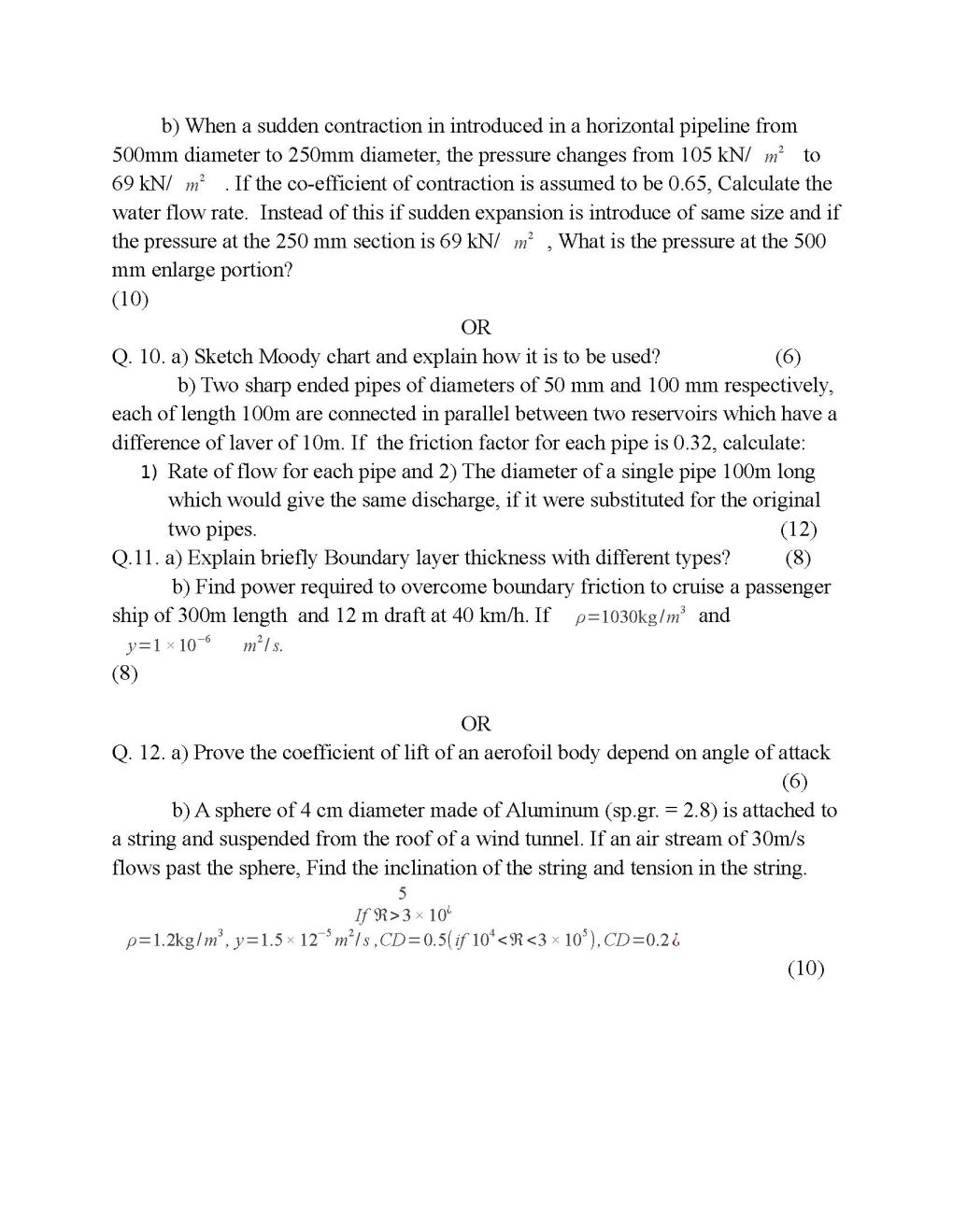|
#1
June 26th, 2013, 11:10 AM
| |||
| |||
|
Hey I am looking for the Pune University old question papers of Mechanical Engineering so can you please provide me? Hello friend as you want the Pune University Question Papers of Mechanical Engineering so here I am providing you the same…. SECTION -1 Q. 1 a) What is the fluid? What are different types of fluid? Explain. (6) b) State and Explain the Newton’s law of viscosity? (4) c) A shaft of 150 mm diameter moves in a sleeve of length 300 mm at a speed of 0.5 m/s under the applications of 200 N force in the directions of its motions. If the clearance between the shaft and sleeves is 0.08 mm, Calculate in viscosity of the lubricating oil in the gap if the applied force is increased to 1000 N, what will be the speed of the sleeve? (8) OR Q. 2. a) What is surface tension? Derive equation of intensity of pressure for . (6) 1)Droplet 2)Bubble 3)Liquid jet b) Differentiate between path line, streakline and streamline. (6) c) If v=(10 x2 y ) i+(15xy) j+( 25t−3xy) k , find acceleration of a fluid particle at (1,2,-1) and t = 0.5. (6) Q. 3 a) Derive an expression for total pressure and center of pressure for and inclined plane surface, immersed in static mass of a liquid. (6) b) State and explain the Archimedes’s principle. (4) c) Explain with neat sketches, the condition of equilibrium for floating and submerged bodies. (6) OR Q. 4. a) State and explain Pascal’s law. (2) b) Prove that the center of the pressure of a plane surface is always below the center of gravity when immersed in liquid. (6) c) A wooden block 60cm long, 25cm wide and 20cm deep has its shorter axis vertical with the depth of immersion 10cm. Calculate the position of the metacentre and comment on the stability of the block. (8) Q. 5 a) Derive Euler’s equations of motions along a streamline and further derive Bernoulli’s equation From that. (8) b) Describe a venturimeter and find an expression for measuring discharge of fluid through a pipe with this device. (8) OR Q. 6. a) What is pitot tube? How is it used? (6) b) What is the notch? Find an expression for measuring the discharge of fluid across a triangular notch. (4) c) With the help of a neat sketch, explain the working of an Orificemeter (6) SECTION -2 Q. 7. a Derive Hagen-Poiseuille equation for steady uniform laminar flow through circular pipe. (8) b Show that Pressure drop Δp of a flowing fluid through a pipe can (8) expressed in the from: L/D Δp=ρV2Ø¿ , μ/ ρVD, H /D¿ OR Q. 8. a) Explain Froude model law and Weber model law. (4) b) A pipe 60 mm diameter and 450 m long slopes upwards at 1 in 50. An oil of viscosity 0.9 Ns /m2 and specific gravity 0.9 is required to be pumped at the rate of 5 lps. (12) 1) Is the flow laminar? 2) What is the power of the pump required assuming an overall efficiency Of 65% 3) What is the center line velocity and velocity gradient at pipe wall? Q. 9. a) Derive the expression for loss of head due to sudden contraction. (8) b) When a sudden contraction in introduced in a horizontal pipeline from 500mm diameter to 250mm diameter, the pressure changes from 105 kN/ m2 to 69 kN/ m2 . If the co-efficient of contraction is assumed to be 0.65, Calculate the water flow rate. Instead of this if sudden expansion is introduce of same size and if the pressure at the 250 mm section is 69 kN/ m2 , What is the pressure at the 500 mm enlarge portion? (10) OR Q. 10. a) Sketch Moody chart and explain how it is to be used? (6) b) Two sharp ended pipes of diameters of 50 mm and 100 mm respectively, each of length 100m are connected in parallel between two reservoirs which have a difference of laver of 10m. If the friction factor for each pipe is 0.32, calculate: 1) Rate of flow for each pipe and 2) The diameter of a single pipe 100m long which would give the same discharge, if it were substituted for the original two pipes. (12) Q.11. a) Explain briefly Boundary layer thickness with different types? (8) b) Find power required to overcome boundary friction to cruise a passenger ship of 300m length and 12 m draft at 40 km/h. If ρ=1030kg /m3 and y=1×10−6 m2/ s. (8) OR Q. 12. a) Prove the coefficient of lift of an aerofoil body depend on angle of attack (6) b) A sphere of 4 cm diameter made of Aluminum (sp.gr. = 2.8) is attached to a string and suspended from the roof of a wind tunnel. If an air stream of 30m/s flows past the sphere, Find the inclination of the string and tension in the string. 5 If ℜ>3×10¿ ρ=1.2kg /m3 , y=1.5×12−5m2/ s ,CD=0.5(if 104<ℜ<3×105),CD=0.2 ¿ (10) SECTION-I Q. 1. A) Compare Otto, and Dual cycle for: (8) i. Constant maximum pressure and same heat input ii. Same compression ratio and same heat input iii. Same max pressure and same output B) A S.I. engine working on Otto cycle takes the air in at 0.97 bar (10) and 40˚C. The compression ratio of the cycle is 7. The heat supplied during the cycle is 1.2 MJ/kg of working fluid. Find: i. Air standard efficiency of the cycle ii. Maximum temperature attained in the cycle iii. Maximum pressure attained in the cycle iv. Work done per kg of working fluid 2 v. Mean effective pressure Take ϒ=1.4, Cv=720J/kg-k OR Q. 2. A) Derive an expression for thermal efficiency of a diesel cycle with (8) usual notation. B) Explain pumping and friction losses and their effects on the power (5) Output of the engine. C) State the assumption made for air standard cycle. (5) Q. 3. A) Explain with neat sketch the following systems of a carburetor (7) i. Idling system ii. Chock B) The diameter for a venture of a simple carburetor is 2cm and its (9) Cda=0.85. The fuel nozzle diameter is 1.25 mm and Cdf=0.66. The lip of the fuel nozzle is 5 mm. Find: i. A:F ratio for pressure drop of 0.07 bar when nozzle lip is neglected. ii. A:F ratio when the nozzle lip is considered. iii. The minimum velocity of air required to start the fuel flow when lip Provided. Take density of air = 1.2 kg/m3 and density of fluid=750 kg/m3. OR Q. 4. A) Explain the basic requirements of a good combustion chamber of (8) S.I. engine and draw a neat sketch of T-head combustion chamber. B) Explain the phenomenon of pre-ignition. How pre-ignition leads to (8) detonation and vice-versa? Explain how pre-ignition can be detected? 3 Q. 5.A) How air-less injection systems are classified? Explain the working (8) of distributer system with the help of neat sketch. Discuss their relative merits and demerits. B) What are the functions of a nozzle? Explain various types of nozzles (8) With neat sketches. OR Q. 6.A) Explain the stage of combustion in CI engine. (8) B) What is meant by ignition delay? Explain the effect of following (8) factors on the ignition delay with suitable reason. i. Compression Ratio ii. Engine size iii. Engine speed SECTION-II Q. 7. A) What are the basic requirements of an ideal ignition system? (4) B) What are the desirable properties of good lubricating oil? (4) C) What are the main functions of lubricating system? Explain dry (8) Sump lubricating system. OR Q. 8.A) Define the functions of radiators. Discuss different type of matrices (8) used with these radiators with neat sketch. B) Explain the working of spring loaded mechanical governor with the (8) help of neat sketch used for Diesel engine. Q. 9. A) The following observations are made during a trial on an oil engine (12) 4 -Motor power to start the engine =10kW -R.P.M.=1750 -Brake Torque = 327.5Nm -Fuel used = 15 kg/hr -C.V. of fuel used = 42MJ/kg -Air supplied = 4.75 kg/min -Quantity of cooling water = 16 kg/min -Outlet temperature of cooling water = 65.8˚C -Room temperature = 20.8˚C -Exhaust gas temperature = 400˚C -Take Cpw = 4.2kj/kg. K and Cpg = 1.25kj/kg.K Determine : i. B.P. ii. Mechanical efficiency iii. BSFC iv. Draw a neat balance sheet on k W basis and percentage basis. B) Write a short note on: (6) i. Heat balance sheet. ii. Various factors affecting volumetric efficiency. OR Q. 10. A) A six cylinder gasoline engine operators on the four stroke cycle. (10) The bore of each cylinder is 80 mm and stroke 100 mm. the clearance Volume per cylinder is 70CC. At a speed of 4000 r.p.m., the fuel Consumption is 30 kg/hr. and the torque developed is 150 N.m 5 Calculate: i. The brake power ii. The brake mean effective pressure iii. The brake mean thermal efficiency Assume the C.V. of fuel as 43,000 kJ/kg. Also estimate relative efficiency When engine works on constant volume cycle with = 1.4 for air. B) What is the dynamometer? Name the various types of dynamometer. (8) Explain the Eddy current dynamometer with the help of a neat sketch. Q. 11. A) Enlist the specification of an automobile engine. (6) B) What is air pollution? Explain the contributors to air pollution and (6) their harmful effects on humans beings. C) Mention the modifications required if hydrogen is used in SI engine (4) As a substitute fuel. OR Q. 12. Write short notes on: (16) i. Hybrid electric vehicle ii. Emission control methods for IC engines. iii. Exhaust gas recirculation. iv. Euro norms SECTION І UNIT NO : 1 Q1) a)State clausius and kelvin planck statements of second law of Thermodynamics and prove their equivalence [08] b) Explain the principal of increase of entropy [08] (OR) Q2) (a) Write a short note on: PMM-І and PMM- ІІ [04] (b) What are the limitations of first law of Thermodynamics [04] (c) Explain clausius inequality? [04] (d) What is COP? How will you calculate COP for a refrigerator and heat pump? [04] 1 UNIT NO : 2 Q3)(a) Explain Helmholtz and Gibbs function [04] (b) Explain second law of efficiency [04] (c) Explain : [08] 1) Available energy 2) Unavailable energy 3) Dead state 4) Equation of state OR Q4) a) 60 liters of hydrogen at 20°c and 1 bar is compressed adiabatically to 9.8 bar. It is then cooled at constant volume to a pressure P3 such as to have temp of 20°c and further expanded isothermally so as to reach initial state find: 1) Work done during each process 2) Change in internal energy during each process Take cp = 14.4 kj/kg k Take cv = 10.28 kj/kg k Show the process on P-V and T-S plane [10] (b) Derive an expression for work done if process is polytropic. [10] UNIT : 3 Q5)(a) Compare carnot and Rankine cycle [4] (b) Explain the following terms: [08] 2 1) Wet steam 2) Dry steam 3) Superheated steam 4) Critical point (c) With a neat Sketch, explain working of separting and throttling Calorimeter [06] (OR) Q6) a) A steam power plant operating on rankine cycle, receives steam at 3.5 MPa and 350°c. it is exhausted to condenser at 0.1 bar calculate : 1) Energy supplied per kg of steam generated in boiler 2) Quality of steam entering the condenser 3) Rankine cycle efficiency considering feed pump work 4) Specific steam consumption [12] c)Explain the effects various parameters on the performance of the Rankine cycle [06] SECTION ІІ UNIT NO : 4 Q7) a) Explain bomb calorimeter with a neat sketch [06] b) A fuel having chemical formula C7 H 16 is burnt with 10% excess air. Assume 90% carbon burnt to CO2 and remaining to CO. Determine volumetric analysis of dry flue gases. [10] OR Q8) a)Explain Orsat apparatus with a neat sketch [06] 3 b) A hydrocarbon fuel has the following orsat analysis: CO2 = 12.5% CO = 0.3% O2 = 3.1% N2 = 84.1% Determine 1) Air-fuel ratio 2) Fuel composition on mass basis 3) Percentage of excess air supplied [10] UNIT NO : 5 Q9) (a) Define: 1) Isothermal efficiency 2) Volumetric efficiency 3) F.A.D [06] (b) Explain Vane compressor with a neat sketch [04] (c) For a single stage single acting reciprocating air compressor, actual volume of air taken in is 10m3/min. Initial intake pressure is 1.013 bar and initial temp is 27°C. Final pressure is 900Kpa, clearance is 6% of stroke. Compressor runs at 400 rpm. Assume: L/D = 1.25 and index of compression = 1.3 4 Determine : 1) volumetric efficiency 2) Cylinder dimensions 3) Indicated power [06] OR Q10) (a) Explain the methods of improving isothermal efficiency of air compressor [06] (b)A 2 stage single acting ir compressor takes in air at 1 bar and 300k. Air is discharged at 10bar. The intermediate pressure is ideal and intercooling is perfect. The law of compression is PV1.3=C The rate of discharge is 0.1 kg/sec. Find 1) Power required to drive the compressor 2) Saving in work compared to single stage 3) Isothermal efficiency for single and multistage 4) Heat rejected in intercooler Take Cp= 1kj/kg k and R= 0.287 kj/kg k [10] UNIT NO : 6 Q11) (a)Write a short note on : boiler draught [04] (b) Explain : 1) Boiler efficiency 2) Equivalent of evaporation [04] (c) Write a short note on IBR [04] 5 (d) Explain : superheater with a neat sketch [06] OR Q12) a) During a boiler trail, the following readings were recorded : Duration of trail : 8 hours Steam pressure : 14bar Dryness fraction : 0.973 Feed water evaporated : 26,700 Feed water temp : 50°C Coal used : 4260 kg Calorific value of coal : 28,900 kj/kg Air used : 17 kg/kg of coal Temp of flue gases : 344°C Boiler room temp : 21°C Cp of flue gases : 1.1 kj/kg k Determine 1) Boiler efficiency 2) equivalent of evaporation 3) heat lost to the flue gases / kg of coal and in percentage [10] (b) State the salient features of high pressure boilers [05] (c) Compare boiler mountings and accessories [03]     Rest of the paper here I am attaching pdf file please download it…. Last edited by Anuj Bhola; October 16th, 2019 at 02:03 PM. |
